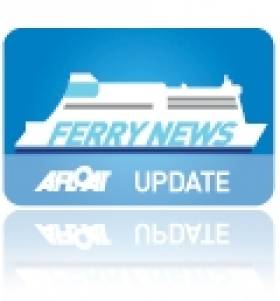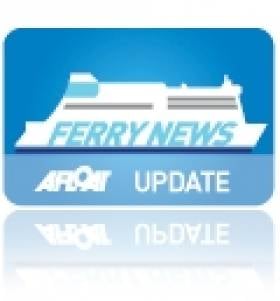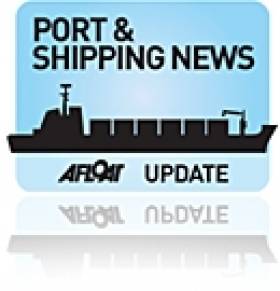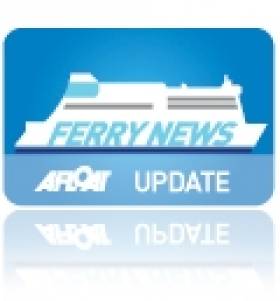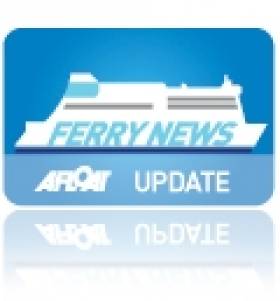Displaying items by tag: Stena Caledonia
#CycleFerry – Only seconds into the Giro d'Italia Discover Northern Ireland TV advert, there's a fleeting glimpse of a Harland & Wolff built ferry that was involved in the logistics of the last prestigious cycling race to this island, the Tour de France in 1998, writes Jehan Ashmore.
The footage shows Belfast's iconic yellow shipyard gantry cranes, Samsun and Goliath, (this weekend flooded at night in pink to reflect Giro D'Italia's pink jersey) and the former Stena Line ferry, Stena Caledonia.
As previously reported on Afloat.ie she was sold to Indonesian interests and renamed Port Link. Following the end of the three stages of the Tour de France, Stena Caledonia carried out a special chartered sailing for the cycling's vehicle entourage from Rosslare to Roscoff.
The Wexford-Breton route then, nor now, is operated by the company, though this Spring Stena Line acquired the operations of Celtic Link Ferries route to Cherbourg. Stena's first ever Ireland-continent route is served by Stena Horizon, an Italian flagged ro-pax ferry registered in Bari. After the three Irish stages, the Adriatic port is incidently the destination to where the first 'Italian' stage of the 97th Giro d'Italia finishes next Tuesday.
Likewise to the three stages of the Tour de France, the logistics involved were not only confined to Rosslare. As additional charters of two other Stena Line ferries were drafted in, Stena Challenger and Koningin Beatrix which called to Cork (Ringaskiddy ferry terminal), a first for the company. The pair also sailed to Roscoff.
Returning to the Stena Caledonia, as seen in the Giro D'Italia advert, she was berthed under the shadow of the giant gantry cranes at the Queen Island berth until her sale to PT ASDP Indonesia Ferry (Persero) and delivery voyage from Belfast Lough in 2012 as Port Link.

Portlink berthed at Belfast, close to the H&W shipyard cranes, the vessel is seen on the Giro d'Italia as the previously named Stena Caledonia, noting full Stena Line corporate livery and stern bridge. Photo Jehan Ashmore
She was the final member of a quartet of 'Saint' class ferried ordered for original owners, Sealink / British Rail and launched in 1981 as St. David.
Of the foursome, she was the only one designed with a stern-bridge so to ease operations during berthing in the restricted confines of the inner harbour in Holyhead while on the Dun Laoghaire route, in which she seldom served.
It was also apt that yesterday's 'Grande Partenza' or Big Start, saw the cyclist team trails set off from the Titanic Quarter, at the site to where a former slipway once occupied another ship built at the yard', the White Star liner RMS Titanic in 1912.
Only three years previously the Giro d'Italia was founded in 1909 and after a century later (with exceptions due to two world wars), the start of this year's Giro has for the first time begun outside mainland Europe.
Ports & Shipping Review: Champagne Voyage, Cruiseship Safety, Scienceship, Ferry Sold, P&O 175th,Belfast Boost
#PORTS & SHIPPING REVIEW - Over the last fortnight Jehan Ashmore has reported from the shipping scene which saw the second WFSV Gardian 10 make a delivery 'Champagne 'promo-voyage to her UK East coast based owners.
Following the Costa Concordia incident, tighter inspections of vessels visiting our ports will be carried out according to the Marine Survey Office.
With all things scientific with the ESOF conference in Dublin, as part of Dublin City of Science 2012, there is still time to apply for the Marine Institute's training position for their research vessel operations.
The last ever passenger (incl. car-ferry) built by Harland & Wolff in 1981, the St. David for Sealink/British Rail departed on her long delivery voyage for new Indonesian owners. For most of her career she served as the Stena Caledonia on the North Channel routes until her recent sale and renaming to Portlink.
P&O Cruises Arcadia sailed into Dublin Bay following a spectacular gathering of her fleetmates in Solent waters to celebrate the 175th anniversary of the world famous shipping company. P&O can trace their origins with an Irish connection as the Dublin and London Steam Packet Co. chartered their paddle-steamer William Fawcett, the vessel being regarded as the first ship working for P&O.
Belfast Harbour revealed record traffic levels for the year 2010-2011 as outlined at the company's annual report. The port showed a 2% rise in profit before taxation to £17.8m and a 4% increase in turnover to £36.1m.
Also in the northern port, the new iconic waterfront landmark of the Belfast Titanic visitor attraction is a key contributory factor in drawing the cruiseship sector. A total of 41 cruise callers are scheduled in 2012 which is an increase to last year's 32 ships.
Belfast Bids Farewell as Last Harland & Wolff built Irish Sea ‘Sealink’ Ferry Sets Sail
#FERRY DEPARTS FOR INDONESIA – An end of an era was marked this afternoon with the departure of the last passenger ship (including 'Sealink' car-ferry) built by Harland & Wolff, when Portlink, slipped down Belfast Lough, for the last time, for new owners in South East Asia, writes Jehan Ashmore.
Since November the ferry then named Stena Caledonia was withdrwan from Stena Line's Belfast-Stranraer route following the opening of a new €80m ferry terminal at Loch Ryan Port close to Cairnryan. The new route is also operated by a pair of larger, newer 'Superfast' sisterships built in 2001, while the older ferry embarks on a career with PT ASDP Indonesia Ferry (Persero).
Originally Stena Caledonia started her career as the St. David, which was launched in 1981 as the final member of a quartet of 'Saint' class near sisterships for Sealink/ British Rail. With her sale to overseas owners, she was the last of the Saint class still operating in UK waters.
Before today's start of the delivery voyage which includes a port of call to Gibraltar, invariably to call for bunkers, the 31 year-old veteran vessel, had been berthed close to the H&W's Musgrave yard. The St. David became the last vessel launched from that particular yard at the Queens Island complex. Incidentally she would also become the last ever passenger ship built at H&W.
For over the last two decades Stena Caledonia has provided a sterling service operating on the North Channel, firstly from Larne-Stranraer when Sealink was taken over by Stena Line in 1990 and then the route switched several years later to the Belfast-Stranraer route.
While in her earlier career as St. David she operated on two routes she was purpose built for between Dun Laoghaire-Holyhead and Rosslare-Fishguard, though she rarely served on the St. Georges service.
Instead she was deployed mostly on the Dun Laoghaire-Holyhead route alongside St. Columba, where these vessels featured a stern-bridge. The stern-bridge in itself also reflected an end of an era in ferry design, this was to facilitate easier and safer access while navigating the tighter confines of the inner harbour of the Welsh port located on Holy Island.
In between her early and final years on the Irish Sea, St. David also ran on routes from Dover where Sealink /British Rail operated their 'Blue' Ribbon service to Calais maintained by two of her three sisters.
Ports & Shipping Review. Cargoships, WFSVs, Cork Ferry, IMERC, Dutch Navy & Last H&W Ferry Sold
#PORTS & SHIPPING REVIEW - Over the last fortnight Jehan Ashmore reports from the shipping scene which saw a 'Pop-Up Village' delivered by cargoship to Galway Port in readiness for the Volvo Ocean Race festival which started yesterday and continues to 8 July.
Arklow Marine Services second wind-farm support vessel (WFSV) Gardian 10 was launched for UK owners and today the vessel travelled from Arklow to Belfast Port and berthed at the Abercorn Basin.
In the rebel county, efforts to revive the Cork-Swansea route took a new step when a group was formed to ascess the feasibility in re-launching the Celtic Sea link that closed last November after Fastnet Line went into examinership.
At the Taoiseach's Public Service Excellence Awards, the Irish Maritime Energy Research Centre (IMERC) based in Haulbowline, Cork Harbour, won an award which was presented by Minister for Justice Alan Shatter T.D. at a ceremony held in Dublin Castle.
Across the world the International Maritime Organisation (IMO) highlighted the Day of the Seafarer on 25 June, where the role of those who work on ships provide a vital service in transporting essential goods on a global scale to meet our needs on a daily basis.
Dublin Port welcomed a flotilla from the Royal Netherlands Navy this weekend, where two of the vessels including a torpedo-training ship HNMLS Mercuur (A 900) was open to the public.
Today the cruiseship Saga Sapphire made her maiden 'Irish' port of call to Cobh having entered service in March for UK based operator Saga Cruises. The 706-passenger capacity ship is due to dock at Dublin Port tomorrow morning.
Former North Channel ferry stalwart Stena Caledonia which operated on the Larne/Belfast-Stranraer routes since 1990 has been sold by Stena Line to ASDP Ferry of Indonesia. She is the last ever passenger ship to have been built by Harland & Wolff shipyard in Belfast.
#STENA SALE SHIP- Irish Sea ferry stalwart Stena Caledonia (1981/12,619grt) has been sold to ASDP Ferry of Indonesia according to Ships Monthly. The vessel remains moored in Belfast awaiting her delivery voyage, which will be the longest ever she is to undertake in her career, writes Jehan Ashmore.
All Stena Line funnel and hull markings of the 31-year old vessel have been painted out and she has been renamed Portlink and re-registered in Jakarta, the capital of Indonesia.
Since late November she stood down following the switch of Scottish ferryport from Stranraer to Cairnryan, where a new £80m Loch Ryan Port ferry terminal is served by two newly introduced and luxuriously refurbished sisters Stena Superfast VII and Stena Superfast VIII. The pair built in Germany in 2001 have successfully been introduced on the new Belfast-Cairnryan route.
Initially the Stena Caledonia was laid-up in Belfast at Albert Quay though in recent months she shifted berths to the former Outfit Quay at Harland & Wolff, ironically this location being very close to the facilities Musgrave Yard, where she built as St. David for Sealink / British Rail.
She became the last vessel to be launched from that particular yard on Queens Island and historically she is significant in that she is the last passenger (including car-ferry) vessel to be built by H&W.
#FERRY NEWS - The veteran Stena Line ferry Stena Caledonia was spotted on sea trials in Belfast Lough last weekend pending its possible sale.
As Irish Sea Shipping reports, ASDP Ferry of Indonesia is thought to have an interest in acquiring the passenger vessel.
Stena Caledonia was withdrawn late last year to make way for Stena's second 'Superfast' ferry on the Belfast-Cairnryan route, as previously reported on Afloat.ie.
Pete Hodson captured a number of photographs as she made her way around the lough on Sunday 27 May, which can be seen HERE.
Stena Sale Ferry to Spanish Operator
#FERRY NEWS- Stena Navigator which served on the former Belfast-Stranraer route, has been sold to overseas buyers. She was one of three ferries made redundant following the switch pf ports to a new ferry terminal in Cairnryan and introduction of larger vessels, writes Jehan Ashmore.
Having only been introduced on the North Channel in late 2009, Stena Navigator (PHOTO) is now set to embark on a new career in the Mediterranean with Spanish operator Baleària. The company operates routes linking the islands to the Spanish mainland in addition to the Strait of Gibraltar, where the ferry is to start service.
The 1,650-passenger, 280-vehicle capacity vessel is currently berthed at Albert Quay, Belfast, before she makes her delivery voyage.
Launched in 1984 as Champs Elysees at Dubigeon Normandie, Nantes Saint Nazaire, for SNCF's Dover-Calais route. She then spent service Stena Line as Stena Parisien between Newhaven-Dieppe before been sold to SeaFrance. This saw her return to the Dover Strait as SeaFrance Manet until eventually sold back to Stena Line.
Berthed ahead of the 15,229grt ferry is her former fleetmate Stena Caledonia, built at the nearby Harland & Wolff and upriver the HSS Stena Voyager is berthed at VT4 Terminal. Since been laid-up the vessels were transferred to a Stena subsidiary, Northern Marine Management (NMM).
Historic Days on North Channel Ferry Routes
#FERRY NEWS- In the space of two days, Stena Line opened a new ferry route between Belfast-Cairnryan today following yesterday's closure of services between Belfast-Stranraer, writes Jehan Ashmore.
Sisters Stena Superfast VII and Stena Superfast VIII inaugurated sailings on the 2 hour 15 minute with 12 crossings daily, and in which will use a new £80m ferry terminal at Loch Ryan Port, Cairnryan and the VT4 terminal in Belfast. The relocation of Scottish ports and terminal investment cost £200m.
The newcomers have a capacity for 1,200 passenger /660 vehicles or 110 freight units. They received a refit and upgrade in Poland where new luxurious facilities such as a Nordic Spa, interactive lounge zone with the latest in technology and free Wi-Fi access throughout the vessel and VIP lounges were installed. To read more click HERE.
At 204m and over 30,000 tonnes each the German built pair are easily the largest ever ferries to operate in the North Channel and will compete with rivals P&O Larne-Cairnryan route served by the 20,000 tonnes sisters European Causeway and European Highlander both built in Japan.
The introduction of the former Scandinavian serving sisters directly replaced Stena Caledonia and HSS Stena Voyager from the Belfast-Stranraer route which only started in 1995. Prior to then Stena Line had operated a service from Larne, which could trace ferry services for the last 123 years.
The Swedish ferry company decided to abandon the route in favour of Belfast. This development also saw the introduction of the second revolutionary HSS 1500 series catamaran ferry HSS Stena Voyager in tandem with various conventional tonnage used over the last sixteen years. The final sailings at the weekend marked the closure of nearly 140 years of several ferry operators running between Stranraer at the end of Loch Ryan and Belfast.
With the withdrawal of HSS Stena Voyager and Stena Caledonia yesterday, she joins former fleetmate Stena Navigator in Belfast, which stood down from Stranraer service last week as previously reported, to read click HERE.
Stena Superfast VII Departs Poland for New Belfast-Cairnryan Route

The New Superfast leaves Gdansk
The 30,285grt newcomer and her sister Stena Superfast VIII will become the largest ever ferries running on the North Channel , though prior to entering service on 21 November, they will undertake berthing trials and crew training.
For the next two-years the sisters are on charter from Scandinavian operators Tallink, and are to operate the new 2 hour 15 minute route with 12 crossings daily. The ten-deck ships can carry up to 1200 passengers, 660 cars or 110 freight units. The sisters will be re-gistered in their new homport of Belfast.
The relocation of Scottish ferry port and the introduction of the Superfast sisters will replace the existing pair of conventional ferry tonnage, Stena Caledonia and Stena Navigator (1984/15,229gt) the latter vessel is believed to be sold. In addition HSS sailings will cease causing the HSS Stena Voyager to become redundant, she was the second of the trio of pioneering HSS 1500 craft built.
When Stena Superfast VII departed Gdansk, she passed the Stena Vision which operates Stena Line's Karlskrona-Gdynia route, the Baltic Sea city lies to the west of Gdansk. Also in Gdansk was the Stena Feronia, the former Irish Sea serving Visentini built ro-pax Dublin Seaways, which was operated albeit briefly by DFDS Seaways last year on the Dublin-(Birkenhead) Liverpool service.
She served under her new Scandinavian owners but the firm's first foray into the Irish market lasted a mere six months. DFDS Seaways sold their Irish Sea network to Stena Line (to read report click HERE) with the exception of their Dublin-Birkenhead service which closed. In addition the Dublin-Heysham freight-only route which closed until re-opened by Seatruck Ferries. The route is currently served by Anglia Seaways, the freightferry which DFDS previously used on the route is on charter to the operator.
- DFDS Seaways
- Baltic Sea
- Stena Line
- Ports and Shipping News
- Seatruck Ferries
- North Channel
- Stranraer
- Dublin Seaways
- Ferry news
- Tallink
- Loch Ryan Port
- HSS Stena Voyager
- Stena Caledonia
- Stena Navigator
- Belfast Lough News
- HSS
- Visentini ropax
- BelfastCairnryan
- Stena Superfast VII
- Stena Superfast VIII
- Stena Superfast
- Superfast Sisters
- North Channel ferry routes
- Stena Feronia
- LRP
- BirkenheadBelfast
- DublinBirkenhead
Award Winning Stena Line Look Forward to New Northern Route
"We are moving into a very important time for Stena Line's operation between Northern Ireland and Scotland. On November 21 we are scheduled to start our new Belfast to Cairnryan service which will also see the introduction of two new vessels, Stena Superfast VII and Superfast VIII, the largest ships every to have sailed between Northern Ireland and Scotland," he continued.
Stena Line's switch of Scottish terminal from Stranrear to the new purpose built facility in Cairnryan which is some 8-miles closer to the open sea along Loch Ryan will reduce sailing times by 35 minutes down to 2 hours 15 minutes.
The 30,285grt Stena Superfast VII and Superfast VIII sisters can carry 1,200 passengers, 660 cars and 110 freight-unit / trucks. In addition they have a novel Nordic Spa facility incorporating a sauna and Jacuzzi.
The 206m pair will compete with rivals P&O (Irish Sea) which operates also from a neighbouring terminal in Cairnryan where another pair of sisters European Highlander and European Causeway provide 2-hour sailings to Larne.
Currently Belfast-Stranraer sailings are served by conventional tonnage ferries Stena Caledonia and Stena Navigator which lost engine-power on 14 October, to read more click HERE.
In addition fast-sailings are run by the expensive to operate HSS Stena Voyager which manages a faster crossing time on the existing route by shaving 15 minutes off the link between Loch Ryan and Belfast Lough. In 2008 the terminal in Belfast was relocated downriver to Victoria Terminal 4 (VT4) on the eastern edge of the port from the older inner-city terminal at Albert Quay.
Stena are to lease the 'Superfast' pair for three years from Scandinavia operator Tallink and they are to directly replace both the HSS and conventional ferries.



























